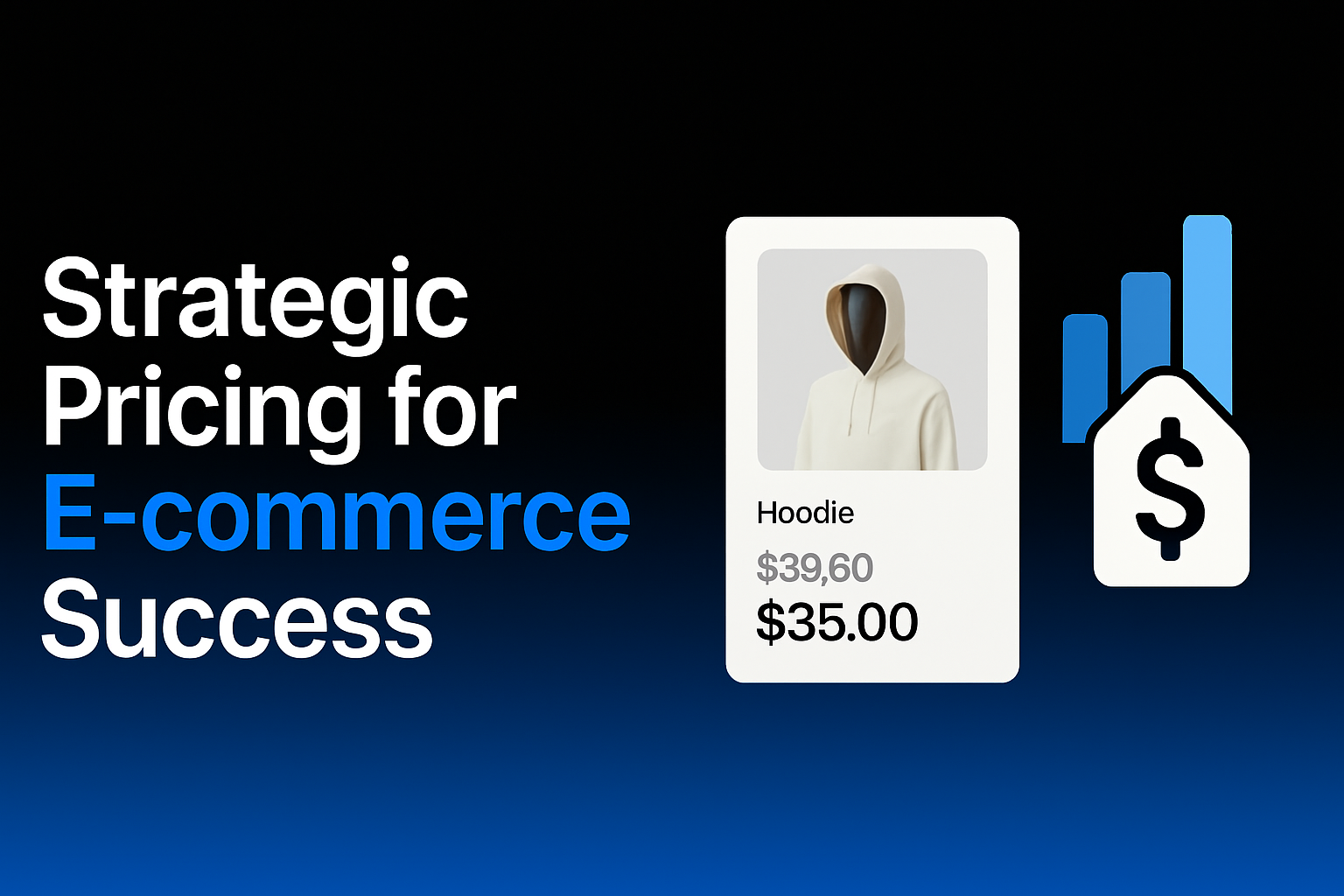Strategic Product Pricing: A Comprehensive Guide for E-commerce Success
Finding the right price point for your e-commerce products represents one of the most critical business decisions you'll make. Effective pricing requires balancing multiple factors: covering your costs, generating sufficient profit margins, meeting market expectations, and reflecting your product's unique value. Too high, and you risk alienating potential customers; too low, and your business sustainability suffers.
In today's competitive digital marketplace, developing a strategic approach to pricing isn't optional—it's essential for long-term success. The most successful e-commerce businesses approach pricing as both a science and an art, leveraging data analysis while understanding the psychological aspects of how consumers perceive value.

Why Strategic Pricing Is Critical for E-commerce Success
Your pricing strategy affects virtually every aspect of your business performance:
Revenue and Profitability
The most obvious impact of pricing is on your bottom line. Each pricing decision directly influences your revenue per sale and overall profitability, affecting your ability to sustain and grow your business.
Market Positioning
Pricing communicates powerful signals about your brand positioning. Premium pricing suggests quality and exclusivity, while lower pricing may indicate value or accessibility. Your pricing strategy should align with your broader brand narrative.
Customer Perception
Consumers increasingly use price as a proxy for quality assessment. The price you set creates expectations about product quality and value that significantly influence purchasing decisions.
Competitive Advantage
Strategic pricing can create meaningful differentiation in crowded marketplaces, helping your products stand out against competitors with similar offerings.
According to recent research, optimizing pricing strategy can improve profit margins by 20-50% for e-commerce businesses, making it one of the highest-leverage activities for improving financial performance.
Foundational Steps to Developing Your Pricing Strategy
Before selecting a specific pricing approach, establish a solid foundation with these essential steps:
1. Conduct Comprehensive Market Research
Understanding the market context is crucial for effective pricing. Research should include:
Competitor Analysis: Thoroughly examine competing products across various price points, noting:
- Price ranges for similar products
- Features and quality relative to price
- Promotional patterns and discount strategies
Target Audience Research: Gather insights about customer expectations and price sensitivity through:
- Surveys and focus groups
- Analysis of purchasing patterns
- Social media and review monitoring
Industry Benchmarking: Identify standard pricing practices within your specific vertical to understand industry norms and consumer expectations.
2. Calculate All Product Costs
Accurate cost calculation forms the foundation of profitable pricing. Be comprehensive in considering:
Direct Costs:
- Manufacturing or wholesale costs
- Packaging materials
- Shipping and fulfillment expenses
- Payment processing fees
Indirect Costs:
- Marketing and advertising expenditures
- Platform and technology fees
- Customer service operations
- Overhead allocation
Hidden Costs:
- Returns and exchanges
- Inventory management
- Seasonal fluctuations
- Currency exchange (for international sales)
3. Define Your Value Proposition
Clarify what makes your offering distinctive before setting prices:
- Identify unique product features or benefits
- Assess quality differentiators from competing products
- Consider convenience factors or service enhancements
- Evaluate brand equity and reputation effects
4. Establish Target Profit Margins
Determine the profit margins required for business sustainability:
- Research industry-standard margins for your product category
- Consider your business model and operational efficiency
- Account for reinvestment needs for future growth
- Adjust for product lifecycle stage and competitive intensity
Seven Effective Pricing Strategies for E-commerce
With foundational research complete, consider these proven pricing strategies for your e-commerce business:
1. Cost-Plus Pricing
This straightforward approach adds a fixed percentage markup to your total product costs.
How to implement:
- Calculate comprehensive product costs (as outlined above)
- Add a predetermined markup percentage based on profit objectives
- Regularly review and adjust as costs change
Best for:
- Products with stable, predictable costs
- Industries with standardized markup practices
- Businesses needing a simple, consistent approach
Limitations:
- Ignores market demand and competitor positioning
- Doesn't account for perceived value differences
- May leave profit potential untapped for premium products
2. Competitive Pricing
This market-oriented strategy positions your prices relative to competitors.
Implementation approaches:
- Match Pricing: Setting identical prices to key competitors
- Discount Pricing: Positioning slightly below competitors to attract price-sensitive customers
- Premium Positioning: Setting prices moderately higher with clear value differentiation
Best for:
- Highly competitive markets with similar products
- New market entrants seeking to establish position
- Products with high price transparency
Limitations:
- Can trigger race-to-the-bottom price wars
- Reduces focus on unique value proposition
- May constrain profit margins unnecessarily
3. Value-Based Pricing
This customer-centered approach sets prices based on the perceived value and benefits your product delivers, rather than just costs or competition.
Implementation requirements:
- Robust understanding of customer needs and pain points
- Clear articulation of value proposition
- Strong brand positioning and product differentiation
- Effective communication of benefits relative to price
Best for:
- Products with distinctive features or benefits
- Established brands with strong reputation
- Items solving significant customer problems
- Luxury or premium market segments
Limitations:
- Requires substantial market research
- More challenging to communicate value effectively
- May limit market size to customers who recognize value
4. Dynamic Pricing
This sophisticated approach involves adjusting prices in real-time based on various factors including demand, inventory levels, time of day, competitor movements, and customer behavior.
Implementation approaches:
- Time-Based Fluctuation: Varying prices by time of day, week, or season
- Demand-Responsive Pricing: Adjusting based on current demand patterns
- Inventory-Based Adjustment: Modifying prices to manage stock levels
- Personalized Pricing: Offering different prices to different customer segments
Best for:
- High-traffic stores with substantial data capabilities
- Products with variable demand patterns
- Businesses with advanced analytics capabilities
- Seasonal items or perishable inventory
Limitations:
- Requires sophisticated technology implementation
- May create customer confusion or distrust
- Needs continuous monitoring and management
5. Bundle Pricing
This strategy involves grouping related products together and selling them at a price lower than the sum of individual item prices.
Implementation approaches:
- Pure Bundling: Items available only within the bundle
- Mixed Bundling: Products available individually and in bundles
- Complementary Bundling: Grouping items that work together
- Cross-Category Bundling: Combining products from different categories
Best for:
- Complementary product offerings
- Inventory with slow-moving items
- New product introductions
- Increasing average order value
Limitations:
- May reduce per-item profit margins
- Requires careful product selection and valuation
- Not effective for all product types
6. Penetration Pricing
This aggressive growth strategy involves setting initially low prices to rapidly capture market share, with plans to increase prices after establishing a customer base.
Implementation approach:
- Set prices significantly below competitors initially
- Focus marketing on price advantage
- Build customer base and loyalty
- Gradually increase prices as market position strengthens
Best for:
- New market entrants
- Products with network effects or viral potential
- Markets with high switching costs after adoption
- Businesses with long customer lifetime value
Limitations:
- Initial revenue sacrifice required
- Can create price-focused customer relationships
- Potentially difficult to raise prices later
- May trigger competitive response
7. Price Skimming
This strategy involves setting high initial prices for new or innovative products, then systematically lowering them over time.
Implementation approach:
- Launch with premium pricing for early adopters
- Emphasize unique features and innovation
- Gradually reduce prices to access broader market segments
- Maintain premium positioning through product evolution
Best for:
- Truly innovative or unique products
- Strong brand with loyal customer base
- Products with high perceived value
- Industries with regular product iterations
Limitations:
- Requires genuine innovation or uniqueness
- Limited to certain product categories
- May create customer frustration upon price drops
- Works best with continuous product improvement
Implementing Your Pricing Strategy: Practical Guidelines
Once you've selected a pricing approach, follow these implementation best practices:
1. Test Before Full Implementation
Conduct controlled price testing to validate your strategy:
- A/B test different price points with similar customer segments
- Monitor not just conversion rates but also average order value
- Evaluate impact on customer acquisition cost
- Measure effects on repeat purchase behavior
2. Communicate Value Effectively
Price is never viewed in isolation—customers evaluate it in the context of perceived value:
- Clearly articulate product benefits and unique features
- Use comparative information when advantageous
- Highlight quality indicators and social proof
- Consider price presentation formats (e.g., monthly vs. annual, unit pricing)
3. Build Flexibility Into Your Strategy
Market conditions change rapidly in e-commerce, requiring pricing agility:
- Develop clear processes for regular price reviews
- Establish criteria for when adjustments are needed
- Create frameworks for promotional pricing
- Plan seasonal or cyclical pricing adaptations
4. Monitor Key Performance Indicators
Track these metrics to evaluate pricing effectiveness:
- Conversion rates at different price points
- Margin contribution by product
- Price elasticity (how demand changes with price adjustments)
- Competitor price movements
- Customer feedback regarding value perception
Final Recommendations for E-commerce Pricing Success
Effective pricing strategy implementation requires ongoing attention:
- Maintain competitive awareness while avoiding purely reactive pricing
- Regularly reassess your cost structures as suppliers, shipping, and operational expenses change
- Gather continuous customer feedback about price-value perception
- Test incremental adjustments rather than dramatic price changes
- Consider segment-specific pricing for different customer groups when feasible
- Evaluate psychological pricing tactics such as charm pricing (e.g., $9.99 vs $10)
- Align pricing with overall marketing strategy and brand positioning
Conclusion
Strategic product pricing represents one of the most powerful levers for e-commerce profitability and market positioning. Rather than treating pricing as a one-time decision, successful businesses view it as an ongoing process requiring regular analysis, testing, and refinement.
By understanding your costs, researching your market, clearly defining your value proposition, and strategically selecting appropriate pricing methodologies, you can develop a pricing approach that balances profitability with customer acquisition and retention.
Remember that no single pricing strategy works for all products or market conditions. The most successful e-commerce businesses often employ multiple strategies across their product catalog, continuously optimizing based on performance data and market evolution.
